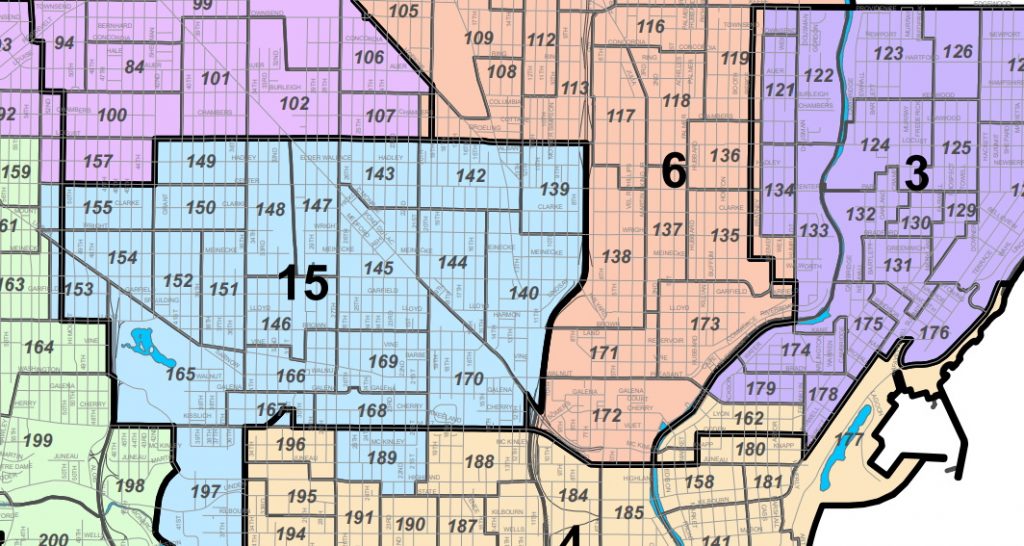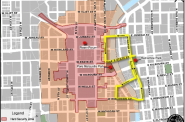Barrett Pushed To Veto New Council Map
Voces de la Frontera calls for creation of third majority-Hispanic district.
The City of Milwaukee’s redistricting process might not be over yet.
Voces de la Frontera, a Latino-focused immigrant and workers’ rights organization, is calling for Mayor Tom Barrett to veto the council’s map and adopt one targeted at creating a third majority Latino district within the decade.
Barrett, according to his communications director, is still reviewing the maps and discussing the redistricting process with a number of people. He has 10 business days to issue a veto.
The Common Council adopted its final map on Nov. 23 on a 14-1 vote, concluding its portion of a “warp speed” process created by delays at the federal, state and county level. Only Alderwoman JoCasta Zamarripa voted against the final map. In an interview after the vote, she expressed concern with Latino representation and the lack of alternatives considered.
The city is now 39.3% Black, 32.3% white, 20.1% Hispanic and 5.6% Asian. When considering only the voting age population, the city is 38.6% white, 36.1% Black, 17.6% Hispanic and 5.1% Asian.
The resulting 15 districts maintain the balance of six Black majority districts, two Hispanic districts and five white districts of which two are being described as Hispanic “influence” districts. There is no legal definition for an “influence” district, but the council is informally defining it as a 25% voting bloc. Two districts have no racial or ethnic majority.
Voces believes that within the decade the new 13th district would become majority Hispanic. Demographic changes from the past two decades indicate that is a strong possibility, but voter turnout patterns indicate that a strong Hispanic majority would be needed to have a meaningful impact.
Zamarripa, in discussing her vote with Urban Milwaukee, agreed with the Legislative Reference Bureau’s (LRB) assessment that drawing three majority-Hispanic districts would be difficult without resorting to unusual shapes or diluting the Hispanic majorities in the existing districts.
“My experience is consistent with what LRB discovered,” said Spiker on Nov. 22 of his attempt to create a third Latino majority district.
Voces’ proposed new districts, drawn as a concept map by LRB, would substantially redefine how the city’s far south side is divided up. The 13th district would become a long, narrow district running south from S. Chase Ave. between Interstate 94 and S. 27th St. to the city’s southern border at W. Wood Ave. The 14th district would be expanded south to include the airport and the surrounding neighborhoods.
The districts are currently split on north-south orientation W. Morgan Ave. and S. Whitnall Ave.
Zamarripa told Urban Milwaukee that Jesus Salas, on behalf of Voces, was one of the stakeholders that reached out to encourage her and her colleagues to vote no on the maps. She also credited Forward Latino director Darryl Morin and Milwaukee Election Commission deputy director Jonatan Zuniga.
LRB said the maps were drawn to comply with the federal Voting Rights Act and that efforts were also made to keep neighborhoods together by following major streets, rivers and other barriers. The smallest and largest districts must not be more than 10% different in size.
The new district map will go into effect for the 2024 spring elections for all 15 council seats. Any special election occurring before that time, under state law, would occur with new wards, but under the prior district lines. The election commission would need to accommodate or restrict voters in the new, redrawn wards so that those voting align with those eligible under the prior districts.
The council adopted a new ward map on Nov. 17 which will impact where and with whom residents vote beginning with the spring 2022 elections. Any new district map also needs to follow the lines set forth by the wards. Barrett signed the ward map into law.
The terms Latino, Latinx and Hispanic were used interchangeably in this piece to represent the comments of a speaker or the wording of a document.
Maps and Statistics
- Voces Concept Map
- Adopted District Map – Detailed
- Adopted District Map – 11×17
- Adopted District Map Demographics
- Adopted 2021 City Ward Map
- 2012 Ward Map
- 2012 Common Council Districts
- 2000 to 2010 Population Change by Aldermanic District
- 2010 to 2020 Population Change by Aldermanic District
- 2020 Population Change by Wards
- 2020 Aldermanic District Demographics
More about the Milwaukee County redistricting process
- Op Ed: Muslim Community Needs Representation - Janan Najeeb - Jan 29th, 2022
- City Hall: Council Ends Redistricting With Anger, Tears - Jeramey Jannene - Jan 18th, 2022
- Statement from Milwaukee Mayor Cavalier Johnson - Mayor Cavalier Johnson - Jan 18th, 2022
- City Hall: Latino Leaders Could Sue Over Redistricting - Jeramey Jannene - Jan 14th, 2022
- Latinx Leaders Condemn Common Council’s Refusal to Draw New Districts Reflecting Dramatic Growth of Latinx Population; Demand Second Legal Opinion - Voces de la Frontera - Jan 14th, 2022
- Voces de la Frontera Statement on Redistricting Decision - Voces de la Frontera - Jan 11th, 2022
- Statement on redistricting decision - Ald. JoCasta Zamarripa - Jan 10th, 2022
- City Hall: Milwaukee Starts Over On Redistricting, Only To Adopt Same Map Again - Jeramey Jannene - Jan 10th, 2022
- Statement by Milwaukee Mayor Tom Barrett: - Mayor Tom Barrett - Dec 14th, 2021
- City Hall: Council Halts Redistricting After Latino Pushback - Jeramey Jannene - Dec 14th, 2021
Read more about Milwaukee County redistricting process here
Political Contributions Tracker
Displaying political contributions between people mentioned in this story. Learn more.
- October 30, 2019 - JoCasta Zamarripa received $100 from Darryl Morin
- August 30, 2019 - Marina Dimitrijevic received $50 from Jesus Salas
- June 30, 2019 - JoCasta Zamarripa received $200 from Darryl Morin
- June 24, 2019 - JoCasta Zamarripa received $125 from Jesus Salas
- June 24, 2019 - JoCasta Zamarripa received $25 from Jonatan Zuñiga
- May 29, 2019 - JoCasta Zamarripa received $250 from Darryl Morin
- April 24, 2019 - JoCasta Zamarripa received $50 from Jesus Salas























